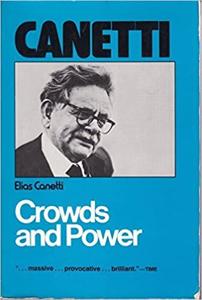
Want to learn the ideas in Crowds and Power better than ever? Read the world’s #1 book summary of Crowds and Power by Elias Canetti here.
Read a brief 1-Page Summary or watch video summaries curated by our expert team. Note: this book guide is not affiliated with or endorsed by the publisher or author, and we always encourage you to purchase and read the full book.
Video Summaries of Crowds and Power
We’ve scoured the Internet for the very best videos on Crowds and Power, from high-quality videos summaries to interviews or commentary by Elias Canetti.
1-Page Summary of Crowds and Power
Overview
Human experience is paradoxical. We are pushed and pulled in different directions by forces beyond our control, which has been explored by some of history’s greatest geniuses. Romeo and Juliet, for example, explores love and hate, while Freud looks at attraction versus repulsion.
Elias Canetti’s Crowds and Power explores the recurring battle between individuality and the urge to lose ourselves in crowds. He takes us from prehistoric packs of hunter-gatherers to the emergence of global religions like Islam and Christianity, and even the nation-state.
This passage helps explain why people who are proud of their individuality seek refuge in groups. The author explains that it has to do with the fact that humans have evolved into a pack, and they’re able to work together as a group because leaders can bribe them with things like money or power.
Big Idea #1: There are five different types of crowd that can be distinguished by their emotional content.
If you’ve ever been stuck in traffic late for work, you might have experienced this:
As the train stops, people’s behavior changes. They were all in their own worlds a few seconds ago, but now they’re united by frustration and anger at the same target: to get the train running again.
A crowd is a large group of people. When members identify with one another, they form a larger entity that’s greater than the sum of its parts. The general traits of crowds are that everyone has equal standing and there’s an emotional connection between them. There are also specific types of crowds based on their emotions—there are five different kinds in total.
Let’s start with the crowd that baited Jesus. It had a clear objective—to kill him.
Crowds form in a variety of situations. Some people are scared and huddle together, but once the danger passes, they disperse.
There are four types of crowds. The first is a prohibition crowd, which consists of people who have the same aim as striking workers in picket lines. Reversal crowds are rebellious and want to overturn power hierarchies, like slaves revolting against their masters or soldiers turning on their officers. Feast crowds consist of people with similar goals that can be indulged together, such as lavish festivals where everyone eats together. All these types have four attributes in common: growth (as soon as they form, they tend to expand), equality (all members are equal once the crowd has formed), density (they’re packed together tightly) and identity (members share a common identity).
Crowds, however, have a goal. Without one, the crowd disperses and everyone returns to their normal lives. For example, after Jesus was crucified by the crowd, they left the scene and returned to normal life.
Big Idea #2: The crowd has its origins in the “pack,” of which there are four different kinds.
Crowds are a big part of society today. It’s not like people have always lived in cities with thousands or millions of other people, though. We evolved from packs and flocks to become the social creatures we are now.
Packs have been around for a long time. They’ve even existed since our ancestors lived in the wilderness. Unlike crowds, which are defined by growth and expansion, packs aren’t open to new members because they’re isolated from other people.
Crowds and packs are similar in some ways, but they differ in others. For example, crowds are more dense than packs. In addition to that, the two have common traits such as equality and direction.
Let’s look at the four different kinds of packs. The first and most natural one is hunting packs, which are designed to kill prey that would be too dangerous for an individual to attack alone.






